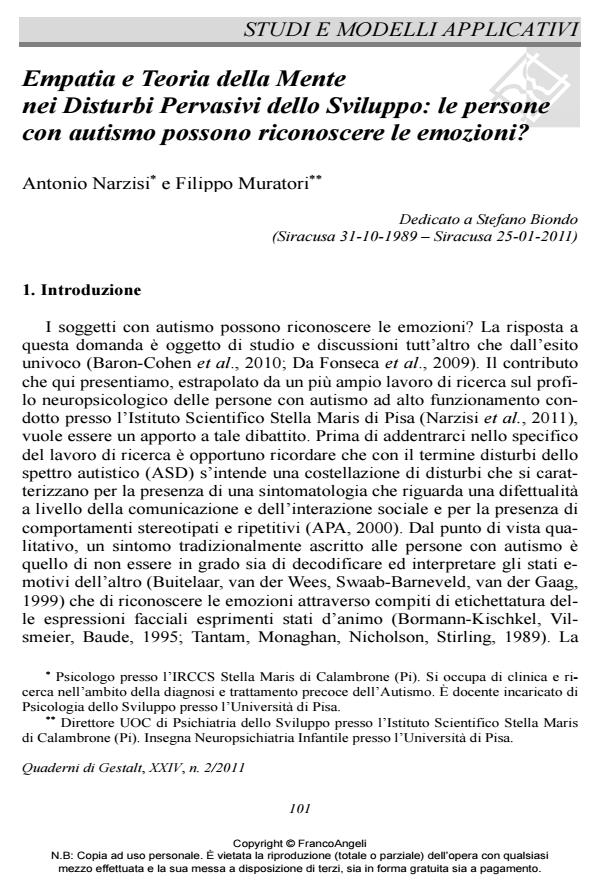Empatia e Teoria della Mente nei Disturbi Pervasivi dello Sviluppo: le persone con autismo possono riconoscere le emozioni?
Titolo Rivista QUADERNI DI GESTALT
Autori/Curatori Antonio Narzisi, Filippo Muratori
Anno di pubblicazione 2012 Fascicolo 2011/2 Lingua Italiano
Numero pagine 12 P. 101-112 Dimensione file 1562 KB
DOI 10.3280/GEST2011-002011
Il DOI è il codice a barre della proprietà intellettuale: per saperne di più
clicca qui
Qui sotto puoi vedere in anteprima la prima pagina di questo articolo.
Se questo articolo ti interessa, lo puoi acquistare (e scaricare in formato pdf) seguendo le facili indicazioni per acquistare il download credit. Acquista Download Credits per scaricare questo Articolo in formato PDF

FrancoAngeli è membro della Publishers International Linking Association, Inc (PILA)associazione indipendente e non profit per facilitare (attraverso i servizi tecnologici implementati da CrossRef.org) l’accesso degli studiosi ai contenuti digitali nelle pubblicazioni professionali e scientifiche
Le persone con autismo possono riconoscere le emozioni? Questa domanda è il focus del lavoro. I risultati del nostro studio mostrano prestazioni deficitarie nelle prove verbali di Teoria della Mente ma non in compiti di Teoria della Mente contestuale, ovvero nella comprensione dei contesti emotivi, suggerendo che la presenza di spunti contestuali è di aiuto per il riconoscimento delle emozioni in bambini con autismo. Questi dati sono stati brevemente discussi attraverso la teoria dell’isomorfismo interpersonale (Psicologia della Gestalt); la teoria della simulazione incarnata (embodied simulation di Gallese); e la teoria del confine di contatto (psicoterapia della Gestalt). Inoltre l’elaborazione locale dell’informazione (livello sistematizzante) non è considerata un ostacolo per l’elaborazione globale/gestaltica dell’informazione e per il riconoscimento delle emozioni ma piuttosto come un segno di neuro-diversità.;
Keywords:Autismo, teoria della mente, terapia della Gestalt, psicologia della Gestalt, isomorfismo interpersonale.
Antonio Narzisi, Filippo Muratori, Empatia e Teoria della Mente nei Disturbi Pervasivi dello Sviluppo: le persone con autismo possono riconoscere le emozioni? in "QUADERNI DI GESTALT" 2/2011, pp 101-112, DOI: 10.3280/GEST2011-002011